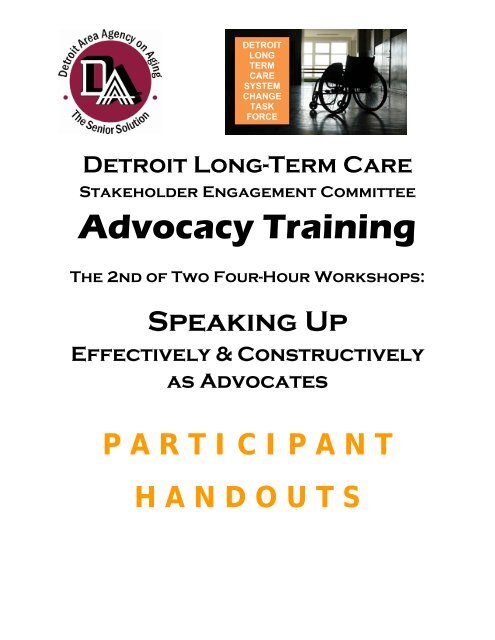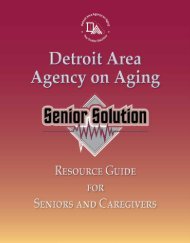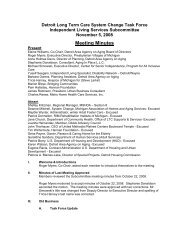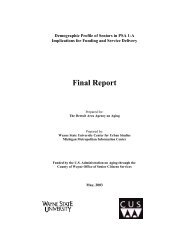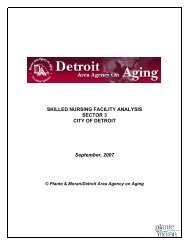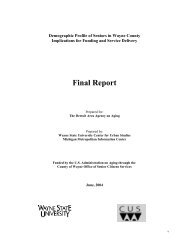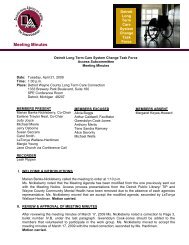Speaking up Effectively and Constructively as Advocates
Speaking up Effectively and Constructively as Advocates
Speaking up Effectively and Constructively as Advocates
Create successful ePaper yourself
Turn your PDF publications into a flip-book with our unique Google optimized e-Paper software.
DETROIT<br />
LONG<br />
TERM<br />
CARE<br />
SYSTEM<br />
CHANGE<br />
TASK<br />
FORCE<br />
Detroit Long-Term Care<br />
Stakeholder Engagement Committee<br />
Advocacy Training<br />
The 2nd of Two Four-Hour Workshops:<br />
<strong>Speaking</strong> Up<br />
<strong>Effectively</strong> & <strong>Constructively</strong><br />
<strong>as</strong> <strong>Advocates</strong><br />
P A R T I C I P A N T<br />
H A N D O U T S
Workshop II: <strong>Speaking</strong> Up <strong>Constructively</strong> & <strong>Effectively</strong> As <strong>Advocates</strong><br />
H<strong>and</strong>out 1: <strong>Speaking</strong> Up <strong>Constructively</strong> & <strong>Effectively</strong> As <strong>Advocates</strong>: Workshop Goals<br />
<strong>Speaking</strong> <strong>up</strong> <strong>Effectively</strong> &<br />
<strong>Constructively</strong> <strong>as</strong> <strong>Advocates</strong><br />
Workshop Goals <strong>and</strong> Objectives<br />
Goals:<br />
To enhance participants underst<strong>and</strong>ing of effective <strong>and</strong><br />
persu<strong>as</strong>ive communications skills<br />
To incre<strong>as</strong>e participants’ confidence in speaking <strong>up</strong> <strong>as</strong><br />
advocates for quality improvements in long-term care<br />
Objectives<br />
Participants who complete this workshop will be able to:<br />
<br />
<br />
<br />
<br />
Describe the characteristics of effective, persu<strong>as</strong>ive <strong>and</strong><br />
constructive communications for advocacy<br />
Identify their own challenges <strong>as</strong> effective advocate<br />
communicators <strong>and</strong> the strategies they will use to<br />
overcome them.<br />
Use pull-back techniques to manage emotions <strong>and</strong><br />
reactions that may undercut effective communications.<br />
Use constructive communication skills to more<br />
effectively advocate for quality in long-term care.<br />
DAAA Stakeholder Engagement Committee Advocacy Training
Workshop II: <strong>Speaking</strong> Up <strong>Constructively</strong> & <strong>Effectively</strong> As <strong>Advocates</strong><br />
H<strong>and</strong>out 2: Best & Worst Experiences Being Persuaded, Recruited, or Enlisted<br />
Being Persuaded, Recruited, Enlisted…<br />
Best Experiences<br />
Worst Experiences<br />
DAAA Stakeholder Engagement Committee Advocacy Training
Workshop II: <strong>Speaking</strong> Up <strong>Constructively</strong> & <strong>Effectively</strong> As <strong>Advocates</strong><br />
H<strong>and</strong>out 3: My Persu<strong>as</strong>ive Strengths <strong>and</strong> Challenges<br />
My Persu<strong>as</strong>ive Strengths <strong>and</strong> Challenges<br />
Quality/Skill<br />
Why It’s a Strength or<br />
Why I Need to Improve<br />
Strategies to<br />
Enhance & Improve<br />
DAAA Stakeholder Engagement Committee Advocacy Training
Workshop II: <strong>Speaking</strong> Up <strong>Constructively</strong> & <strong>Effectively</strong> As <strong>Advocates</strong><br />
H<strong>and</strong>out 4: How Would You Feel If….<br />
How Would You Feel If…<br />
Provocation<br />
1. What provokes you?!?! What<br />
are your “red buttons”?<br />
What You Feel<br />
How It Affects Your<br />
Ability to Communicate<br />
2. You’ve called this Senator’s office<br />
6 times in 3 weeks, <strong>and</strong> they<br />
always say, “She’ll call you soon!”<br />
3. A nursing home representative<br />
you’re speaking with says, “You<br />
people are so damned righteous!<br />
You have no idea what it’s like<br />
trying to run this business.”<br />
4. From your point of view, a young<br />
legislative aide is speaking to you<br />
<strong>as</strong> if he thinks you’re a total idiot.<br />
5. A DAAA staff person you’re<br />
counting on for <strong>as</strong>sistance tells<br />
you that she just can’t help you<br />
because she h<strong>as</strong> too many others<br />
issues on her plate.<br />
6. Another advocate says that she’s<br />
had it <strong>and</strong> is going to quit.<br />
7. Waiting in a hall to speak with<br />
him, you overhear a legislator<br />
say, “The State’s in the tank, <strong>and</strong><br />
these people think I give a damn<br />
about old people who ought to<br />
just be put to sleep so we don’t<br />
have to spend money on them!”<br />
DAAA Stakeholder Engagement Committee Advocacy Training
Workshop II: <strong>Speaking</strong> Up <strong>Constructively</strong> & <strong>Effectively</strong> As <strong>Advocates</strong><br />
H<strong>and</strong>out 5: Pulling Back<br />
When we’re speaking <strong>up</strong> about issues we care deeply about withpeople who are not<br />
responsive, our emotional reactions — anger, hurt, frustration, hopelessness, rage or<br />
sadness – can get in the way. When we are too emotional, speaking constructively <strong>and</strong><br />
powerfully is difficult If we can pull back from our emotions, we have more CHOICE in how<br />
State our point<br />
of view <strong>as</strong> fact,<br />
<strong>as</strong> “right”<br />
Prepare to<br />
defend it.<br />
State our point<br />
of view <strong>as</strong> ours<br />
<strong>and</strong> invite the<br />
other person’s<br />
Listen actively,<br />
to come <strong>up</strong><br />
with shared<br />
React to<br />
differences <strong>as</strong><br />
attacks <strong>and</strong><br />
discounts of<br />
our point of<br />
view<br />
Reject any<br />
We respect<br />
differences<br />
<strong>and</strong> look for<br />
new<br />
information or<br />
insights<br />
Stay open to<br />
j i t l ti<br />
Workshop IV, Session 7: S<strong>up</strong>ervisory Skills II<br />
H<strong>and</strong>out 6: Pull Back Strategies Open Up Options<br />
DAAA Stakeholder Engagement Committee Advocacy Training
Pull Back Strategies Open Up Options!<br />
Pull-Back Strategies I Can Use<br />
How I Could H<strong>and</strong>le Those<br />
Provocations After Pulling Back<br />
__________________________________<br />
__________________________________<br />
__________________________________<br />
__________________________________<br />
__________________________________<br />
__________________________________<br />
__________________________________<br />
__________________________________<br />
__________________________________<br />
__________________________________<br />
__________________________________<br />
__________________________________<br />
__________________________________<br />
__________________________________<br />
__________________________________<br />
__________________________________<br />
__________________________________<br />
__________________________________<br />
__________________________________<br />
__________________________________<br />
__________________________________<br />
__________________________________<br />
__________________________________<br />
__________________________________<br />
__________________________________<br />
__________________________________<br />
__________________________________<br />
__________________________________<br />
__________________________________<br />
__________________________________<br />
__________________________________<br />
__________________________________<br />
__________________________________<br />
__________________________________<br />
__________________________________<br />
__________________________________<br />
DAAA Stakeholder Engagement Committee Advocacy Training
Workshop IV, Session 7: S<strong>up</strong>ervisory Skills II<br />
H<strong>and</strong>out 7: Simple Guidelines for <strong>Speaking</strong> Up About Tough Issues<br />
Simple Guidelines for<br />
<strong>Speaking</strong> Up About Tough Issues<br />
1. Be specific, clear <strong>and</strong> direct about the issue. Tell the person<br />
how it affects you or those you represent…<br />
‣ Check that they are ready to talk <strong>and</strong> that now is a good time.<br />
Example: “Senator Dixon, I’d like to speak with you about enhancing CNA<br />
training to improve our elders’ care. When is a good time to talk?”<br />
2. Use language that does not blame or judge…<br />
‣ Describe the facts <strong>and</strong> the behavior<br />
‣ Avoid characterizing, using absolutes (always, never) or<br />
describing the person or their organization<br />
‣ Avoid giving opinions, <strong>as</strong>sumptions <strong>and</strong> judgments at this time<br />
Example (of what not to say): “Mr. Godwin, your staff are heartless<br />
<strong>and</strong> uncaring. You’re nursing home is a disgrace <strong>and</strong> reflects that you don’t<br />
care about anything but money!”<br />
3. Invite the person to address the issue in a way that works<br />
for both of you, <strong>and</strong> indicate belief in the person <strong>and</strong> their<br />
ability to do it…<br />
Example: (continuing from above) “Mr. Godwin, we’d like to talk with you<br />
about the use of restraints with resident s . We believe they are a poor way<br />
to manage behavior <strong>and</strong> that there are many more effective , cost-saving<br />
<strong>and</strong> respectful options. We know you want to run a good nursing home,<br />
<strong>and</strong> are hoping you’ll work with us.<br />
After speaking. . .<br />
1. LISTEN – Hear the other person’s point of view. Actively listen: Use pull<br />
back, paraphr<strong>as</strong>e <strong>and</strong> open-ended questions<br />
2. ENGAGE IN DIALOGUE – Hold a conversation <strong>and</strong> listen to each other<br />
3. PLAN FOR ACTION – Search for solutions that all can agree to<br />
4. ACKNOWLEDGE – Thank the person <strong>and</strong> acknowledge what you have<br />
accomplished together<br />
Workshop IV, Session 7: S<strong>up</strong>ervisory Skills II<br />
DAAA Stakeholder Engagement Committee Advocacy Training
H<strong>and</strong>out 8: The Five Messages Model of Communicating Your Advocacy Wishes<br />
The Five Messages Model 1<br />
5 Messages Express: Example:<br />
1. What you<br />
are seeing<br />
<strong>and</strong> hearing<br />
What are you or have you seen, heard,<br />
experienced or otherwise sensed?<br />
Tips to Make Your Feedback Effective <strong>and</strong> Constructive:<br />
• Use an “I” statement that “owns” what you are saying<br />
Mr. Godwin, your home h<strong>as</strong><br />
identified 12 residents with<br />
dementia <strong>as</strong> combative in<br />
the l<strong>as</strong>t 6 months <strong>and</strong> sent<br />
them away…<br />
• Describe the facts <strong>and</strong> the behavior. Do not characterize or describe the person,<br />
or include opinions, <strong>as</strong>sumptions <strong>and</strong> judgments. Avoid blaming <strong>and</strong> judging.<br />
• Be specific <strong>and</strong> clear about you are talking about.<br />
2. The impact,<br />
or what you<br />
are feeling…<br />
What impact does it have on you or your<br />
mission? What emotions are you feeling?<br />
I believe this is painful for<br />
the residents, your staff,<br />
<strong>and</strong> your organization…<br />
Tip: • Be honest <strong>and</strong> genuine, <strong>and</strong> do not blame the other person for your feelings.<br />
3. Why you<br />
feel tha t<br />
way –<br />
because…<br />
What interpretations, wants, needs,<br />
memories or anticipations of yours<br />
s<strong>up</strong>port your description of the impact or<br />
feelings?<br />
Tips: • Let the other person know why you are responding <strong>as</strong> you are<br />
• Explain your point of view<br />
4. What you<br />
want now –<br />
<strong>and</strong> now I<br />
want…<br />
What action, information or commitment<br />
do you want now?<br />
Tip: • Include a very specific, clear <strong>and</strong> descriptive request<br />
5. What<br />
outcomes<br />
you hope for<br />
– so that…<br />
What positive results will that action,<br />
information or commitment lead to in<br />
the future – for both/all of you?<br />
Because it disr<strong>up</strong>ts<br />
residents’ lives, stresses<br />
your staff, <strong>and</strong> costs you<br />
time <strong>and</strong> money…<br />
And so, I’d like to <strong>as</strong>k if I<br />
can work with you to offer<br />
training <strong>and</strong> other s<strong>up</strong>ports<br />
to your staff…<br />
So you can provide the high<br />
quality care you want, your<br />
staff will be better able to<br />
h<strong>and</strong>le challenging<br />
situations, <strong>and</strong> residents<br />
will experience less stress...<br />
Tips to Make Your Feedback Effective <strong>and</strong> Constructive:<br />
• Invite the person to accomplish a desired – <strong>and</strong> hopefully, shared – goal<br />
1 Adapted from ‘The Seven Challenges: A Workbook <strong>and</strong> Reader About Communicating More<br />
Cooperatively,” by Dennis Rivers<br />
DAAA Stakeholder Engagement Committee Advocacy Training
Workshop IV, Session 7: S<strong>up</strong>ervisory Skills II<br />
H<strong>and</strong>out 9: Our Five Messages Script for <strong>Speaking</strong> Up<br />
Our Script for <strong>Speaking</strong> Up! 2<br />
The Five Messages<br />
1. What you are you or have<br />
seen, heard , experienced…<br />
Express:<br />
What are you seeing, hearing or otherwise sensing?<br />
2. The impact, or what you are<br />
feeling…<br />
What impact does it have on your constituents or you?<br />
What emotions does this arouse in you or others?<br />
3. Why you feel that way or<br />
believe that’s the impact –<br />
“because…”<br />
What interpretations, wants, needs, memories or<br />
anticipations of yours s<strong>up</strong>port your feelings?<br />
4. What you want now – “<strong>and</strong><br />
now I want…”<br />
What action, information or commitment do you want<br />
now?<br />
5. What outcomes you hope for<br />
– “so that…”<br />
What positive results will that action, information or<br />
commitment lead to in the future – for both/all of you?<br />
2 Adapted from ‘The Seven Challenges: A Workbook <strong>and</strong> Reader About Communicating More Cooperatively,” by<br />
Dennis Rivers. http://www.newconversations.net/communication_skills_workbook_summary_<strong>and</strong>_toc.htm<br />
DAAA Stakeholder Engagement Committee Advocacy Training
Workshop I: Underst<strong>and</strong>ing the Need for Advocacy<br />
H<strong>and</strong>out 10: Opinion Poll<br />
It’s realistic to<br />
believe<br />
that we can transform<br />
the quality of<br />
long-term care<br />
through our<br />
advocacy<br />
efforts.<br />
DAAA Stakeholder Engagement Committee Advocacy Training


